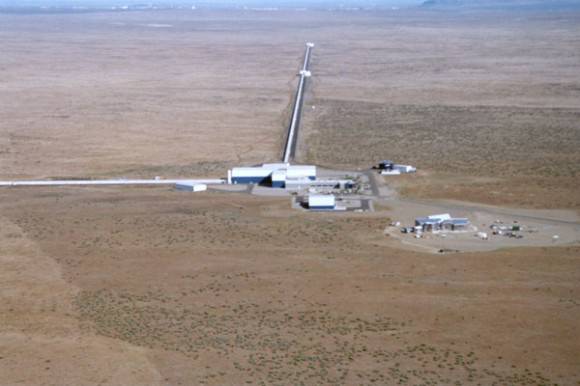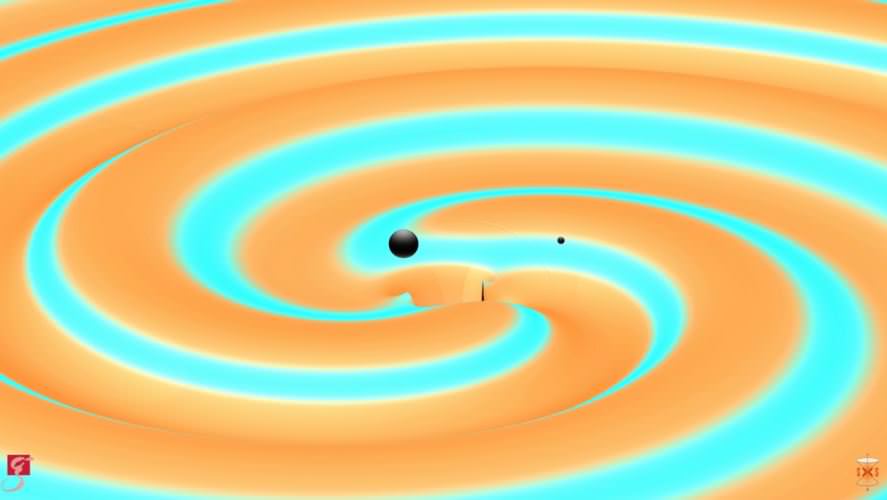Lightning has struck twice – maybe three times – and scientists from the Laser Interferometer Gravitational-wave Observatory, or LIGO, hope this is just the beginning of a new era of understanding our Universe. This “lightning” came in the form of the elusive, hard-to-detect gravitational waves, produced by gigantic events, such as a pair of black holes colliding. The energy released from such an event disturbs the very fabric of space and time, much like ripples in a pond. Today’s announcement is the second set of gravitational wave ripples detected by LIGO, following the historic first detection announced in February of this year.
“This collision happened 1.5 billion years ago,” said Gabriela Gonzalez of Louisiana State University at a press conference to announce the new detection, “and with this we can tell you the era of gravitational wave astronomy has begun.”
LIGO’s first detection of gravitational waves from merging black holes occurred Sept. 14, 2015 and it confirmed a major prediction of Albert Einstein’s 1915 general theory of relativity. The second detection occurred on Dec. 25, 2015, and was recorded by both of the twin LIGO detectors.
While the first detection of the gravitational waves released by the violent black hole merger was just a little “chirp” that lasted only one-fifth of a second, this second detection was more of a “whoop” that was visible for an entire second in the data. Listen in this video:
“This is what we call gravity’s music,” said González as she played the video at today’s press conference.
While gravitational waves are not sound waves, the researchers converted the gravitational wave’s oscillation and frequency to a sound wave with the same frequency. Why were the two events so different?
From the data, the researchers concluded the second set of gravitational waves were produced during the final moments of the merger of two black holes that were 14 and 8 times the mass of the Sun, and the collision produced a single, more massive spinning black hole 21 times the mass of the Sun. In comparison, the black holes detected in September 2015 were 36 and 29 times the Sun’s mass, merging into a black hole of 62 solar masses.
The scientists said the higher-frequency gravitational waves from the lower-mass black holes hit the LIGO detectors’ “sweet spot” of sensitivity.
“It is very significant that these black holes were much less massive than those observed in the first detection,” said Gonzalez. “Because of their lighter masses compared to the first detection, they spent more time—about one second—in the sensitive band of the detectors. It is a promising start to mapping the populations of black holes in our universe.”

LIGO allows scientists to study the Universe in a new way, using gravity instead of light. LIGO uses lasers to precisely measure the position of mirrors separated from each other by 4 kilometers, about 2.5 miles, at two locations that are over 3,000 km apart, in Livingston, Louisiana, and Hanford, Washington. So, LIGO doesn’t detect the black hole collision event directly, it detects the stretching and compressing of space itself. The detections so far are the result of LIGO’s ability to measure the perturbation of space with an accuracy of 1 part in a thousand billion billion. The signal from the lastest event, named GW151226, was produced by matter being converted into energy, which literally shook spacetime like Jello.
LIGO team member Fulvio Ricci, a physicist at the University of Rome La Sapienzaa said there was a third “candidate” detection of an event in October, which Ricci said he prefers to call a “trigger,” but it was much less significant and the signal to noise not large enough to officially count as a detection.
But still, the team said, the two confirmed detections point to black holes being much more common in the Universe than previously believed, and they might frequently come in pairs.
“The second discovery “has truly put the ‘O’ for Observatory in LIGO,” said Albert Lazzarini, deputy director of the LIGO Laboratory at Caltech. “With detections of two strong events in the four months of our first observing run, we can begin to make predictions about how often we might be hearing gravitational waves in the future. LIGO is bringing us a new way to observe some of the darkest yet most energetic events in our universe.”
LIGO is now offline for improvements. Its next data-taking run will begin this fall and the improvements in detector sensitivity could allow LIGO to reach as much as 1.5 to two times more of the volume of the universe compared with the first run. A third site, the Virgo detector located near Pisa, Italy, with a design similar to the twin LIGO detectors, is expected to come online during the latter half of LIGO’s upcoming observation run. Virgo will improve physicists’ ability to locate the source of each new event, by comparing millisecond-scale differences in the arrival time of incoming gravitational wave signals.
In the meantime, you can help the LIGO team with the Gravity Spy citizen science project through Zooniverse.
Sources for further reading:
Press releases:
University of Maryland
Northwestern University
West Virginia University
Pennsylvania State University
Physical Review Letters: GW151226: Observation of Gravitational Waves from a 22-Solar-Mass Binary Black Hole Coalescence
LIGO facts page, Caltech
For an excellent overview of gravitational waves, their sources, and their detection, check out Markus Possel’s excellent series of articles we featured on UT in February:
Gravitational Waves and How They Distort Space
Gravitational Wave Detectors and How They Work
Sources of Gravitational Waves: The Most Violent Events in the Universe


“It is very significant that these black holes were much less massive than those observed in the first detection,” said Gonzalez. “Because of their lighter masses compared to the first detection, they spent more time—about one second—in the sensitive band of the detectors. It is a promising start to mapping the populations of black holes in our universe.”
Interesting that perhaps the smaller the black holes involved the easier it will be to detect their merger. I’m guessing supermassive varietal mergers will be undetectable for the foreseeable future?
I wouldn’t say “foreseeable;” as exciting as this is, I for one am figuratively holding my breath waiting for LISA (much more sensitive space-based version) to come online. ^_^
How the less Mass of black hole is easier to detect more than the big one ?
“Because of their lighter masses compared to the first detection, they spent more time—about one second—in the sensitive band [frequency] of the detectors.”
Meaning (my guess) that it is easier to correlate a long weaker signal than a stronger short burst with model predictions.
Thanks for reply
I have something i understand here ( correct me if i’m wrong ) .
Small black holes mass create long wavelength ripples with low frequency and it’s good for detection more than the short wavelength with high frequency .
Well by golly, SHAKE those protons and rattle all of space/time, Nancy’s back in the house!
These detections rely on Incomprehensibly complex measurements at the sub quantum scale. WOW! It’s like…. “HEY! Which one of you bacteria farted and what are you trying to do, ruin my gravity wave experiment?”
Thanks for the ‘welcome back’ Aqua4U!
Is there such a thing in a black hole condition where matter reaches a critical mass and the entire thing converts into energy?
I would be looking for such a critical mass simply because you have a collision of two black holes into one.
If a black hole reaches a point where things traveling into the hole itself are traveling at speeds approaching the speed of light then it is possible that time itself is corrupted here. Meaning if it goes too fast into the black hole would it actually be traveling backwards in time? The speed itself is a limit. But if something exceeds that limit . . . probably not possible . . . would it become a time object.
Meaning of course that anything internal to the object colliding at huge speeds would have time issues.
It would be at two places at the same time.
Which brings up the subject of a super black hole possibility.
Such a possibility may include turning into a singularity or not.
How close is the nearest small black hole to our solar system?
Is there any evidence at all of a black hole coming apart?
We have enormous conditions where theory states a black hole must be at the center of just about every galaxy out there.
Since we have an unlimited unknown number of galaxies in the Universe dating back at least 13 billion years something has to give.
Since galaxies actually eat each other with their black holes then the structure of a black hole is important.
Great to see my teen Sci-Fi reads becoming fact. Macroscope © Piers Anthony. More sensitivity, more bandwidth and the SDPS is upon us!